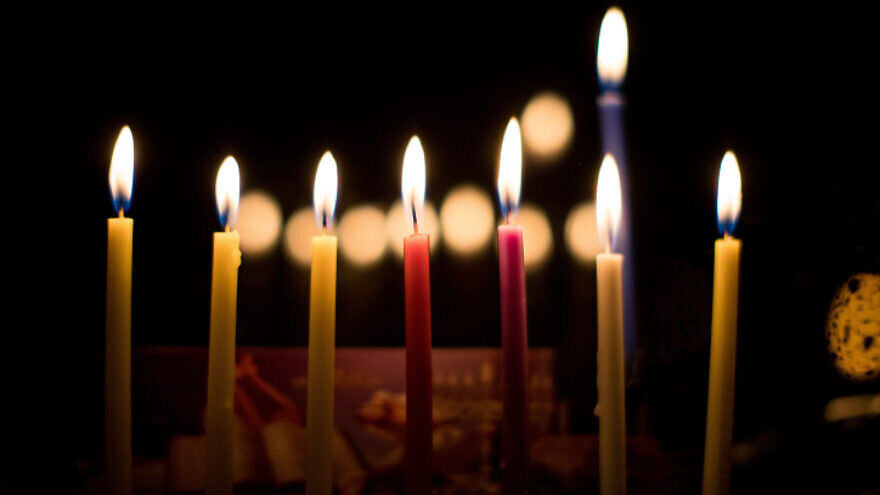The lights are kindled, the shamash is returned to its place and the family breaks into song: It is a rousing, march-like melody that is the aural equivalent of the menorah’s light—energy, joy and hope in the depth of winter, a promise of rebirth.
It’s a familiar, comforting scene, repeated in Jewish homes around the world each year. But what lies beneath the surface?
Originally composed as a poem, or piyyut, to be incorporated into Jewish liturgy, “Ma’oz Tzur” dates to the late 12th or early 13th centuries. No one knows who wrote it, although the author left a hint: The first letters of the first five stanzas spell out “Mordechai.” Some have speculated that he was Mordechai ben Yitzhak Halevy, a rabbi and poet who emigrated from Iraq to Mainz, Germany in the Middle Ages. Whoever he was, Mordechai was angry.
Even in the first verse—the one most people are familiar with—the anger is already apparent. The poet begins by addressing God—ma’oz tzur means “rock of my salvation.” He asks God to restore and rededicate the Temple so that he can express thanksgiving. But then he adds a condition: This rededication can only happen le’eis tachin matbeach, mitzor hamnabeach, “When you have prepared a butchery for the barking enemy.” Yes, that’s the line that swells so majestically in musical rendition. “The hard edges are subsumed by difficult, poetic Hebrew,” says scholar and writer Tamar Ron Marvin. “We tend not to notice the bite of the poem’s actual words.”
Then there’s a sixth stanza. Writing once more in the present tense, the poet returns to the theme of vengeance—only this time, he reveals the identity of the enemy: The stanza contains several barely veiled references to Christianity, including pleas that God bring an end to “Yeshuah” (the Hebrew name for Jesus) and “reject Edom”—a common euphemism for Rome—“in the shadow of the tzelem (cross).”
Because it first appeared in print in the 18th century, the last stanza’s authenticity is hotly debated by scholars. Yitzhak Melamed, professor of philosophy at Johns Hopkins University, points out that its structure and rhyming scheme fit perfectly with the rest of the text. Jews self-censored the poem, transmitting the last stanza surreptitiously for more than five centuries, he says, “in order to avoid provocation and violence.” “Ma’oz Tzur” was written in medieval Germany during the Crusades, when many Jews killed themselves and their families rather than fall prey to their attackers. The fear—and the anger—was real.
‘An act of spiritual resistance’
How did the only piece of Jewish liturgy to explicitly condemn Christianity become a universally popular Hanukkah hymn? “Here I think we simply need to defer to the music. Powerful in choral rendition, fun to sing as a family, the music provides strength and hope,” says Alden Solovy, a liturgist and poet who lives in Israel.
But “Ma’oz Tzur” is more than disturbing lyrics set to a beautiful melody. Despite its dominant negative emotions, the poem is ultimately an expression of courage, Marvin notes: “By reviewing unlikely moments of redemption in Jewish history, the poet convinces himself, and us, that it will be okay in the end. It is an act of spiritual resistance.”
That theme inspired several poets to add their own “Ma’oz Tzur” stanzas, commemorating epochs in modern Jewish history like the Holocaust and Zionism. For example, during Israel’s War of Attrition, the Israeli songwriter Naomi Shemer composed a version in which ma’oz refers to the Bar Lev Line. And after the 2018 Tree of Life massacre in Pittsburgh, Solovy decided to add his own addition. “The timing of the massacre, juxtaposed with the content of the poem, made it an apt choice for my goal of honoring the victims and memorializing the moment, while offering hints of hope and healing,” he says.
Musicians have also tried their hand at adapting “Ma’oz Tzur.” There is a Moroccan version, a Ladino translation with gorgeous music and, of course, the redoubtable Jewish acapella groups have given it their all.
Perhaps it’s not surprising that “Ma’oz Tzur” invites innovation. The poem’s connection to its beloved music, and to the holiday of Hanukkah, are themselves adaptations which have given “Ma’oz Tzur” a significance transcending anything its author could have imagined.
“Many piyyutim are abstruse or unfamiliar,” Marvin says. “But this one, we love. We have a relationship to it, which is an opportunity to connect to our past and be inspired to contribute ourselves, to pass along experiences to the next generations.”


























